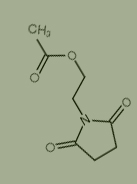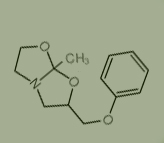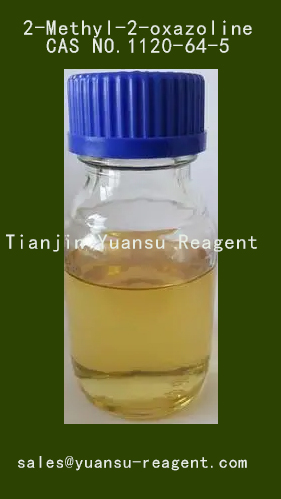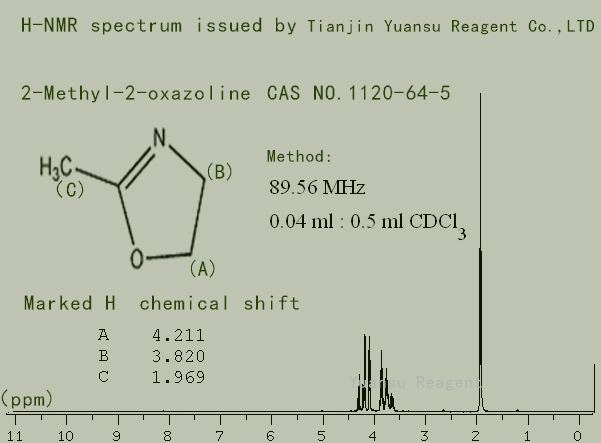2-Methyl-2-oxazoline
What is 2-Methyl-2-oxazoline, cas no. 1120-64-5,a producer telling you the result.
CAS NO. 1120-64-5
If you need the products .Please send your inquiry to us through e-mail: sales@yuansu-reagent.com
To begin with, let us tell you what is the basic information of 2-Methyl-2-oxazoline CAS NO. 1120-64-5 ?
|
Molecular Formula |
C4H7NO |
Molecular Weight |
85.104 |
|
Density |
1.1±0.1 g/cm3 |
Boiling Point |
110.0±0.0 °C at 760 mmHg |
|
Flash Point |
20.0±0.0 °C |
Exact Mass |
85.052765 |
|
EINECS |
214-316-3 |
MD NO. |
MFCD00005298 |

Like many stuff, it has many synonyms as follows
|
Oxazole, 4,5-dihydro-2-methyl- |
|
2-Methyloxazoline |
|
2-Methyl-4,5-dihydrooxazole |
|
2-Methyl-2-oxazoline |
First, the chemical is very special, some technical indexes as below
If you need the products .Please send your inquiry to us through e-mail: sales@yuansu-reagent.com
Physical property data
1. Appearance: Liquid.
2. Density (g/mL, 25 ℃): 1.005
3. Relative vapor density (g/mL, air=1): not determined
4. Melting point (º C): undetermined
5. Boiling point (º C, atmospheric pressure): 109.5-110.5
6. Boiling point (º C, 749mmHg): undetermined
7. Refractive index (n20/D): 1.434
8. Flash point (º C): 20
9. Specific rotation (º): not determined
10. Spontaneous combustion point or ignition temperature (º C): not determined
11. Vapor pressure (psi, 20 º C): not determined
12. Saturated vapor pressure (kPa, 60 º C): not determined
13. Combustion heat (KJ/mol): undetermined
14. Critical temperature (º C): not determined
15. Critical pressure (KPa): undetermined
16. Logarithmic value of oil-water (octanol/water) partition coefficient: undetermined
17. Explosion upper limit (%, V/V): undetermined
18. Lower explosive limit (%, V/V): not determined
19. Solubility: undetermined
toxicology data
Skin and mucous membranes have irritant effects
Ecological data
Slightly harmful to water, do not allow undiluted or large amounts of products to come into contact with groundwater, waterways, or sewage systems. Do not discharge materials into the surrounding environment without government permission
Molecular structure data
1. Molar refractive index: 22.68
2. Molar volume (m3/mol): 78.0
3. Waiting for Zhang Biarong (90.2K): 185.3
4. Surface tension (dyne/cm): 31.7
5. Dielectric constant: not available
6. Bipolar distance (10-24cm3): not available
7. Polarization rate: 8.99
Calculate chemical data
1. Reference value for hydrophobic parameter calculation (XlogP): -0.2
2. Number of hydrogen bond donors: 0
3. Number of hydrogen bond acceptors: 2
4. Number of rotatable chemical bonds: 0
5. Number of tautomers: None
6. Topological molecular polarity surface area 21.6
7. Number of heavy atoms: 6
8. Surface charge: 0
9. Complexity: 77.6
10. Number of isotopic atoms: 0
11. Determine the number of atomic stereocenters: 0
12. Uncertain number of atomic stereocenters: 0
13. Determine the number of chemical bond stereocenters: 0
14. Number of uncertain chemical bond stereocenters: 0
15. Number of covalent bond units: 1
Nature and stability
Stable at room temperature and pressure, avoiding contact with oxides
Storage method
Keep the container sealed and store in a cool, dry place
Second, the Synthetic Route we will recommend is the most important for your reference?


First, synthesis line of 2-Methyl-2-oxazoline CAS NO. 1120-64-5 as follows
The compound with CAS number 1120-64-5 is 2-methyl-2-oxazoline (also known as 2-methyl-2-oxazoline), which has multiple synthetic routes. Here are some known synthetic routes:
1. Synthesis route reported in literature:
According to the search results, there are at least 11 different synthetic routes, which are detailed in academic journals such as Journal of the American Chemical Society, Journal of Organic Chemistry, and Synthesis.
The specific synthesis efficiency can reach about 75%.
2. Common synthesis methods:
The usual synthesis method is to obtain 2 through the oxidation reaction of 2-amino-2-methyl-1-propene.
3. Other possible synthetic pathways:
Due to the diversity and complexity of synthetic routes, there may be other synthesis methods that have not been detailed. These methods may involve different starting materials, catalysts, and reaction conditions.
Third, what is the usage of 2-Methyl-2-oxazoline CAS NO. 1120-64-5 ? pleas see below
If you need the products .Please send your inquiry to us through e-mail:sales@yuansu-reagent.com
2-methyl-2-azoline has a wide range of applications in many fields. It is often used as a catalyst, organic solvent, and inhibitor. In terms of organic solvents, it can be used to dissolve many organic compounds. In addition, 2-methyl-2-azoline is widely used in industrial processes such as coatings, rubber processing, synthetic fibers, and metal cleaning.
Other usages as below
Used for the synthesis of 2-(2,5-dioxopyrrolidin-1-yl)ethyl acetate
Cas no. 28833-81-0

Used for the synthesis of
7a-methyl-6-(phenoxymethyl)-2,3,5,6-tetrahydro-[1,3]oxazolo[2,3-b][1,3]oxazole
Cas no. 13488-71-6
Used for the synthesis of N-(2-Chloroethyl)acetamide
,Cas no. 7355-58-0

Besides Safety Information of 2-Methyl-2-oxazoline CAS NO.1120-64-5 is also important when handling it
|
Hazard Codes |
Xi |
|
WGK Germany |
3 |
|
H.S.Code: |
2934999090 |
|
TSCA |
Yes |
|
HazardClass |
IRRITANT |
What is the appearance of 2-Methyl-2-oxazoline CAS NO.1120-64-5? Please see the picture of 2-Methyl-2-oxazoline CAS NO.1120-64-5, below
If you need the products .Please send your inquiry to us through e-mail: sales@yuansu-reagent.com
Specification of 2-Methyl-2-oxazoline CAS NO.1120-64-5, is below
Apperance: Clear colorless to very faint yellow liquid
Assay: 99 min by GC
IR identity: conform
Water:0.5% max by K.F.
HNMR picture of 2-Methyl-2-oxazoline CAS NO.1120-64-5 is as follows,
IR picture of 2-Methyl-2-oxazoline CAS NO.1120-64-5 is as follows,
Reference of Article cited for your reference below,
(1)
Publication Date: 2022
Publication Name: Polymer Journal
(2)
Cationic Graft Polymerization onto Silica Nanoparticle Surface in a Solvent-Free Dry-System
Publication Date: 2008
Publication Name: Polymer Bulletin
(3)
Copolymerization via zwitterion
Publication Date: 1984
Publication Name: Polymer Bulletin






